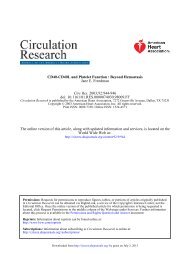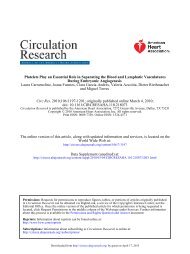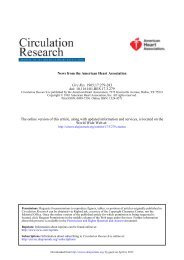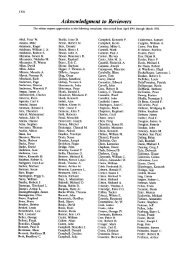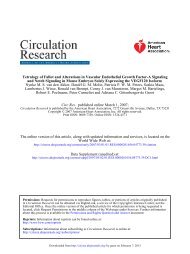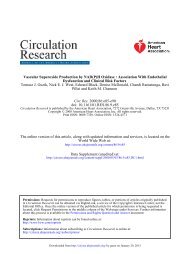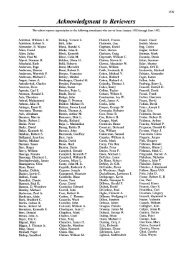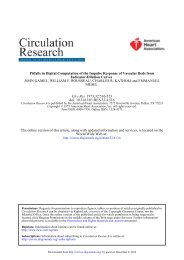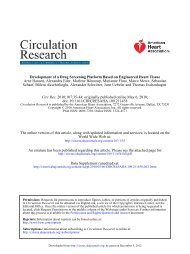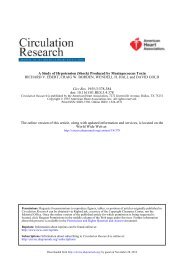Role of Sarcoplasmic Reticulum in Arterial Contraction: Comparison ...
Role of Sarcoplasmic Reticulum in Arterial Contraction: Comparison ...
Role of Sarcoplasmic Reticulum in Arterial Contraction: Comparison ...
Create successful ePaper yourself
Turn your PDF publications into a flip-book with our unique Google optimized e-Paper software.
858 Circulation Research Vol 62, No 4, April 1988<br />
TABLE 1. Contractile Responses to Various Stimuli <strong>in</strong> Rat Aorta and Bov<strong>in</strong>e Tail Artery<br />
A. Maximal contractions <strong>in</strong> response to potassium-depolarization, norep<strong>in</strong>ephr<strong>in</strong>e, i<br />
and caffe<strong>in</strong>e<br />
Maximum contraction amplitude (mg tension + SEM)<br />
Treatment<br />
100 mM K solution<br />
6X 10~ 3 M Norep<strong>in</strong>cphr<strong>in</strong>e<br />
10 mM Caffe<strong>in</strong>e<br />
Rat aorta<br />
1,508 + 206 (6)<br />
1,090 ±433 (4)<br />
158±12 (14)<br />
Bov<strong>in</strong>e tail<br />
artery<br />
1,313±237(7)<br />
678+163(6)<br />
61 ±17 (5)<br />
Bov<strong>in</strong>e tail<br />
artery/rat aorta<br />
0.87<br />
0.62<br />
0.39<br />
B. Rate <strong>of</strong> tension <strong>in</strong>crease <strong>in</strong> 0-calcium, low-sodium solution<br />
Rate <strong>of</strong> tension <strong>in</strong>crease (mg tension/hr + SEM)<br />
Bov<strong>in</strong>e tail<br />
Bov<strong>in</strong>e tail<br />
Treatment<br />
Rat aorta<br />
artery<br />
artery/rat aorta<br />
Control<br />
None<br />
None<br />
10 ^M Ryanod<strong>in</strong>e<br />
n, number <strong>in</strong> parentheses.<br />
205 ±12 (3)<br />
38+14 (3)<br />
0.19<br />
The contractile responses <strong>of</strong> bov<strong>in</strong>e tail artery to<br />
potassium-rich solutions, to brief pulses <strong>of</strong> NE, and<br />
to caffe<strong>in</strong>e are illustrated <strong>in</strong> Figures 8 and 9; the data<br />
are compared with rat aorta <strong>in</strong> summarized form<br />
<strong>in</strong> Table 1A. Potassium-<strong>in</strong>duced contractions <strong>in</strong> bov<strong>in</strong>e<br />
tail artery were comparable to those <strong>in</strong> rat<br />
aorta: they were almost completely abolished<br />
by 10 u,M verapamil (Figure 8) but were unaffected<br />
by ryanod<strong>in</strong>e (Figure 9). Further, a small external<br />
calcium-dependent fraction <strong>of</strong> the response persisted<br />
<strong>in</strong> the presence <strong>of</strong> verapamil. In contrast, the<br />
effects <strong>of</strong> verapamil on NE-<strong>in</strong>duced contractions<br />
were different <strong>in</strong> the two vessels. On average,<br />
NE-<strong>in</strong>duced bov<strong>in</strong>e tail artery contractions were<br />
<strong>in</strong>hibited by 82 ± 8% (SEM, n = 6) as compared with<br />
45 ±2% (n = 4) <strong>in</strong> rat aorta. Conversely, ryanod<strong>in</strong>e<br />
<strong>in</strong>hibited NE-<strong>in</strong>duced contractions by only about<br />
14 ± 3% (n = 6) <strong>in</strong> bov<strong>in</strong>e tail artery (Figure 9) but by<br />
about 52 ±2% (n = 8) <strong>in</strong> rat aorta (see Figure 4). In<br />
bov<strong>in</strong>e tail artery, caffe<strong>in</strong>e elicited brief, small contractions<br />
(Figure 9 and Table 1A), followed by<br />
susta<strong>in</strong>ed relaxation (Figure 9). As <strong>in</strong> rat aorta,<br />
ryanod<strong>in</strong>e blocked the <strong>in</strong>itial caffe<strong>in</strong>e-<strong>in</strong>duced contraction<br />
but did not affect the subsequent relaxation<br />
200 mg<br />
NE<br />
10" 6 M<br />
FIGURE 6. Effect <strong>of</strong> 10 \iM ryanod<strong>in</strong>e on the norep<strong>in</strong>ephr<strong>in</strong>e<br />
(NE) response. In this experiment, unlike others with the rat<br />
aortic r<strong>in</strong>gs (see text), tissue was superfused with 10 "* M NE<br />
cont<strong>in</strong>uously for periods <strong>in</strong>dicated by bars under contraction<br />
records. Tissue was exposed to 10 p.M ryanod<strong>in</strong>e for 60 m<strong>in</strong>utes<br />
before record on right-hand side was obta<strong>in</strong>ed. Rest<strong>in</strong>g tension,<br />
500 mg.<br />
(Figure 9). Note that <strong>in</strong> bov<strong>in</strong>e tail artery, the average<br />
amplitude <strong>of</strong> the caffe<strong>in</strong>e-<strong>in</strong>duced contractions was<br />
less than 5% <strong>of</strong> that <strong>in</strong>duced by high potassium but was<br />
about 10% <strong>of</strong> the average potassium-<strong>in</strong>duced contraction<br />
<strong>in</strong> rat aorta.<br />
When sodium-dependent calcium extrusion was<br />
suppressed by superfus<strong>in</strong>g 0-calcium, 1.2-mMsodium<br />
solution, bov<strong>in</strong>e tail artery exhibited qualitatively<br />
the same response to ryanod<strong>in</strong>e as did rat aorta<br />
(Figure 3): a progressive <strong>in</strong>crease <strong>in</strong> tension, with<br />
rapid relaxation when the standard (139.2 mM)<br />
sodium medium was re<strong>in</strong>troduced. However, the rate<br />
at which this tension developed was much slower <strong>in</strong><br />
the bov<strong>in</strong>e tail artery than <strong>in</strong> rat aorta (Table IB). This<br />
observation, as well as the smaller contractile response<br />
to caffe<strong>in</strong>e and the smaller ryanod<strong>in</strong>e-sensitive<br />
component <strong>of</strong> the NE contraction, <strong>in</strong>dicates that the<br />
bov<strong>in</strong>e tail artery has a relatively small SR store <strong>of</strong><br />
calcium as compared with rat aorta. These data imply<br />
that most <strong>of</strong> the "activator calcium" <strong>in</strong> bov<strong>in</strong>e tail<br />
artery comes from the extracellular fluid.<br />
Morphology and Morphometry <strong>of</strong> Rat Aortic and<br />
Bov<strong>in</strong>e Tail Artery Cells<br />
The 15 arterial myocytes from each species that<br />
were analyzed morphometricalry were a representative<br />
sample <strong>of</strong> the population. These cells appeared<br />
relaxed and did not exhibit swollen vacuoles or other<br />
artifacts.<br />
In overall structure, rat aortic cells (Figure 10)<br />
differed markedly from those <strong>of</strong> the bov<strong>in</strong>e tail artery<br />
(Figures 11 and 12). As described by others, 31 the rat<br />
cells were roughly cuboidal and ranged from about<br />
3 x 7 to 10 x 15 ^m <strong>in</strong> size (Figure 10). SR and rough<br />
endoplasmic reticulum (dist<strong>in</strong>guished by the presence<br />
<strong>of</strong> ribosomes on the surfaces <strong>of</strong> the latter) as well as<br />
mitochondria were abundant and were distributed<br />
throughout the cytoplasm.<br />
Bov<strong>in</strong>e tail artery cells were sp<strong>in</strong>dle shaped and<br />
much larger: 10-15 jim <strong>in</strong> diameter and usually more<br />
than 100 \im <strong>in</strong> length (Figure 12, light microscopy<br />
<strong>in</strong>dicated that most cells were about 10—15 x 125-150<br />
Downloaded from<br />
http://circres.ahajournals.org/ by guest on April 6, 2013




